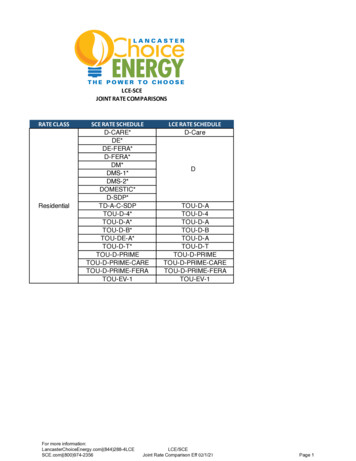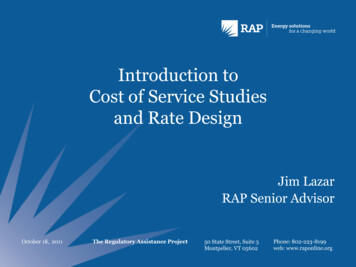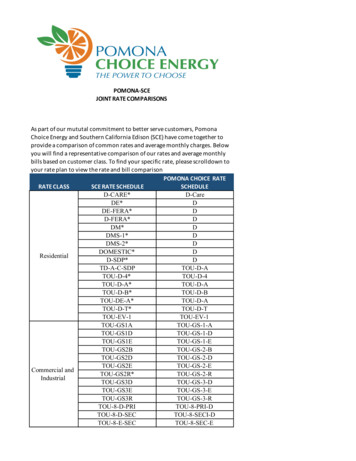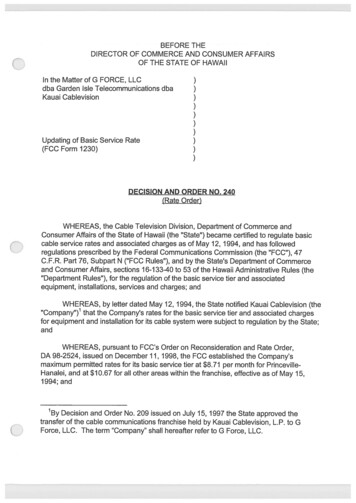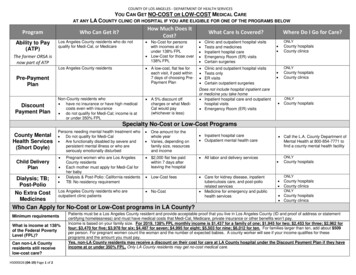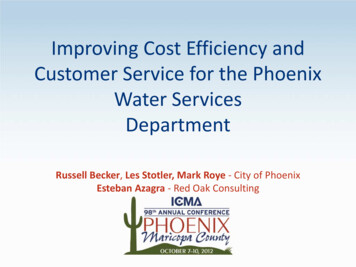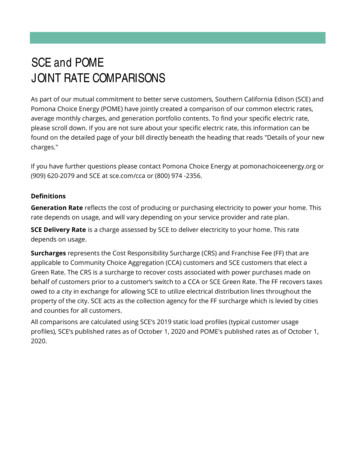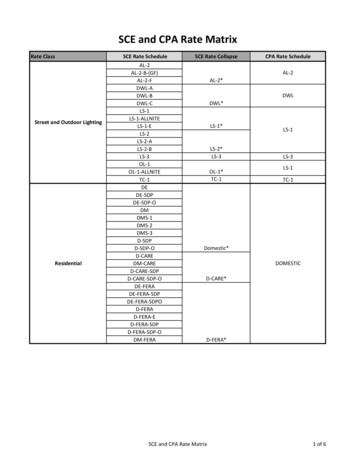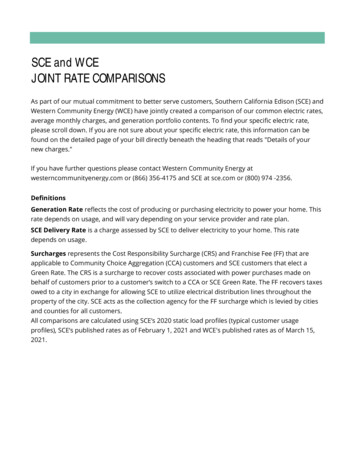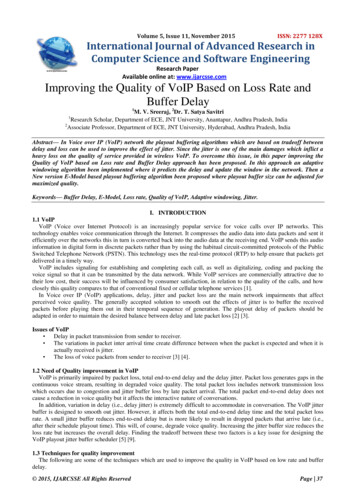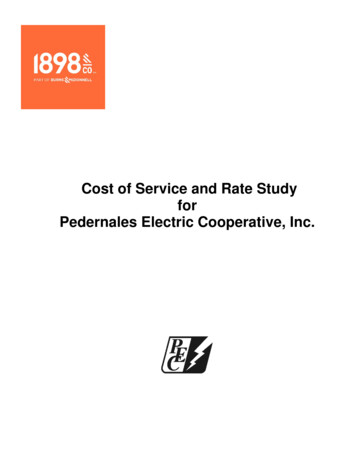
Transcription
Cost of Service and Rate StudyforPedernales Electric Cooperative, Inc.
Cost of Service and Rate StudyTable of ContentsTABLE OF CONTENTSPage No.1.0EXECUTIVE SUMMARY . 1Study Results and Recommendations . 12.0INTRODUCTION . 33.0COST OF SERVICE ANALYSIS . 4Revenue Requirement Analysis. 4Cost of Service Analysis Results . 6Cost of Service Results Review . 63.3.1Residential Class Under Recovery and Rate Alignment . 63.3.2Small Power Over Recovery and Rate Alignment . 63.3.3Large Power Rate Alignment. 73.3.4Interconnect Members Under Recovery and Rate Alignment. 73.3.5Transmission Service Members . 73.3.6ERCOT Transmission Recovery . 74.0COST OF SERVICE RECOMMENDATIONS. 8Merge Residential and Small Power Service into New General ServiceClass . 8Implement Three-Phase differential within the New General ServiceClass . 8Merge All Under 50 kW Interconnect Members into General ServiceInterconnect Class . 8Consolidate Start Up Power and Transmission . 8Eliminate the College Discount Class . 9Eliminate the Water Well class . 9Consolidated Class Summary. 95.0RATE DESIGN AND PLAN. 10Existing Classes . 10Rate Design Initiatives . 102020 Rate Design Initiatives . 115.3.1Eliminate the Water Well Class . 115.3.2Provide Primary Service Option to All Members. 125.3.3Create New Unmetered Non-Lighting Class. 122021 Rate Design Initiatives . 135.4.1Remove College Discount Rider . 135.4.2Remove Revenue Adjustment Factor . 135.4.3New Transmission Service Class . 135.4.4Large Power Cost Based Rate . 13Pedernales Electric Cooperative, Inc.i
Cost of Service and Rate StudyTable of Contents5.4.5Interconnect Member Cost Based Rate. 145.4.6Time-of-Use Power Cost Recovery . 15Proposed Classes and Service Types . 15Pedernales Electric Cooperative, Inc.ii
Cost of Service and Rate StudyTable of ContentsLIST OF TABLESPage No.Table 1:Table 2:Table 3:Table 4:Table 5:Test Year Income Statement . 5Consolidated Classes . 9Existing Classes and Service Types . 10Proposed Class and Service Types – 2021. 16Proposed Class and Service Types – 2022. 16Pedernales Electric Cooperative, Inc.iii
Cost of Service and Rate StudyTable of ContentsLIST OF ABBREVIATIONSAbbreviationTerm/Phrase/NameBurns & McDonnellBurns & McDonnell Engineering Company, Inc.PECPedernales Electric Cooperative, Inc.4 CPFour Coincident PeaksAMIAdvanced Metering InfrastructureAMRAutomated Meter ReadingCPCoincident PeakDCUData Collection UnitDGDistributed GenerationERCOTElectric Reliability Council of TexaskWKilowattkWhKilowatt-hourNCPNon-Coincident PeakRFRadio FrequencySACService Availability ChargeTOUTime-of-UseTCRFTransmission Cost Recovery FactorTCOSTransmission Cost of ServiceTWACSTwo Way Automated Communication SystemPedernales Electric Cooperative, Inc.iv
Cost of Service and Rate StudyDisclaimerDISCLAIMER1898 & Co. is a division of Burns & McDonnell Engineering Company, Inc. which performs or providesbusiness, technology, and consulting services. 1898 & Co. does not provide legal, accounting, or taxadvice. The reader is responsible for obtaining independent advice concerning these matters. That adviceshould be considered by reader, as it may affect the content, opinions, advice, or guidance given by 1898& Co. Further, 1898 & Co. has no obligation and has made no undertaking to update these materials afterthe date hereof, notwithstanding that such information may become outdated or inaccurate. Thesematerials serve only as the focus for consideration or discussion; they are incomplete without theaccompanying oral commentary or explanation and may not be relied on as a stand-alone document.The information, analysis, and opinions contained in this material are based on publicly available sources,secondary market research, and financial or operational information, or otherwise information provided byor through 1898 & Co. clients whom have represented to 1898 & Co. they have received appropriatepermissions to provide to 1898 & Co., and as directed by such clients, that 1898 & Co. is to rely on suchclient provided information as current, accurate, and complete. 1898 & Co. has not conducted completeor exhaustive research, or independently verified any such information utilized herein and makes norepresentation or warranty, express or implied, that such information is current, accurate or complete.Projected data and conclusions contained herein are based (unless sourced otherwise) on theinformation described above and are the opinions of 1898 & Co. which should not be construed asdefinitive forecasts and are not guaranteed.Current and future conditions may vary greatly from those utilized or assumed by 1898 & Co. 1898 & Co.has no control over weather; cost and availability of labor, material, and equipment; labor productivity;energy or commodity pricing; demand or usage; population demographics; market conditions; changes intechnology; and other economic or political factors affecting such estimates, analyses, andrecommendations. 1898 & Co. does not have any duty to update or supplement any information in thisdocument. To the fullest extent permitted by law, 1898 & Co. shall have no liability whatsoever toany reader or any other third party, and any third party hereby waives and releases any rights and claimsit may have at any time against 1898 & Co., Burns & McDonnell Engineering Company, Inc., and anyBurns & McDonnell affiliated company, with regard to this material, including but not limited to theaccuracy or completeness thereof.Pedernales Electric Cooperative, Inc.v
Cost of Service and Rate StudyExecutive Summary1.0EXECUTIVE SUMMARYPedernales Electric Cooperative, Inc. (PEC) requested that 1898 & Co. prepare an updated cost ofservice and rate design study for the cooperative. The Study included the development of a test yearrevenue requirement, a class cost of service analysis, and review of rate design initiatives being proposedby PEC. PEC prepares cost of service studies every three years as required by their internal rate policy.The results of the cost of service and rate design study serve as an input to PEC’s long-term rate planwhich was concurrently prepared by 1898 & Co.PEC has historically adjusted its retail electric rates to reflect changes in the cost it incurs to provideelectric service to its members. PEC has periodically adjusted its rate schedules, or created new rateclasses as the need has arisen due to an identified variation in cost to serve members within a particularrate class. Additionally, PEC has incorporated new offerings for customers so that they can save such aselectronic billing.PEC has continued to experience considerable growth in new membership and energy sales over thepast decade. Most of this growth has occurred in the PEC service area surrounding the City of Austin.This area is more densely populated than the rural areas PEC serves and has allowed PEC to keep itscontrollable costs on a per meter basis relatively constant. As a result, the cost of providing distributionservice to members and revenue requirement has remained flat even when considering inflation.PEC is in ERCOT and has been managing its power supply cost well by purchasing power from bothLCRA and other various power purchase agreements. PEC has been able to manage this cost at a levelsuch that the total power charges to customers (base power cost and power cost adjustment) haveremained relatively flat. PEC also incurs ERCOT transmission cost based on its 4 coincident peak (4 CP)demands during the summer. Over the last 5 years PEC has recovered its transmission cost throughcurrent rates which has varied only slightly year to year keeping cost stable for PEC customers.As part of this study, PEC desires to make adjustments to several of its rate classes and schedules tobetter align with its cost to provide service. These include class consolidation, elimination of severalclasses, and some minor adjustments to several rate schedules which in total do not materially increaseor decrease overall revenues to PEC.Study Results and RecommendationsBased on the analyses and rate reviews completed as a part of this study, the following findings andrecommendations are provided below for 2020 and 2021.-Based on an examination of the financial forecast and test year revenue requirement, PECadequately collects on a system level to recover it’s costs.Pedernales Electric Cooperative, Inc.1
Cost of Service and Rate Study-Executive SummaryThe updated class cost of service analysis indicates that several classes are either over recovering orunder recovering. Recommendations to resolve these issues will be addressed later in this report.-The cost to provide service to each customer class was considered along with the long-term rate planto develop consolidated rate classes for the future where supported by this study. This is furtherexplained in the cost of service section and rate design section of the report.RecommendationsoPEC should eliminate the Water Well rate class and place those customers into the Residentialclass.oPEC should provide all customers not in the new transmission class or unmetered classes the optionto receive primary service.oPEC should remove the college discount rider from the tariff.oPEC should removal the revenue adjustment factor (RAF).oPEC should create a single transmission service class available for all uses and sizes or membersreceiving transmission level service.oPEC should implement a new cost-based rate structure for Large Power members.oPEC should create a new unmetered non-lighting class.oPEC should ensure that the TOU shapes reflect current energy costs.Pedernales Electric Cooperative, Inc.2
Cost of Service and Rate StudyIntroduction2.0INTRODUCTIONPEC requested that 1898 & Co. prepare an updated cost of service and rate design study for thecooperative. The Study included the development of a test year revenue requirement, a class cost ofservice analysis, and review of rate design initiatives being proposed by PEC. PEC prepares cost ofservice studies every three years as required by their internal rate policy. The results of the cost of serviceand rate design study serve as an input to PEC’s long-term rate plan which was concurrently prepared by1898 & Co.The first phase of the Study completed for PEC was the determination of the annual revenuerequirement. This annual revenue requirement is used as the basis for the subsequent phases of thestudy including the cost of service and rate design. The development of the revenue requirementdetermines if PEC is recovering its cost and generating a reasonable return on rate base whilemaintaining other financial targets. This includes the development of revenues, expenses, and otherfinancial projections which were prepared by PEC and used in the study analyses. The test year revenuerequirement also incorporated various inflight rate changes such as the removal of the PCA, removal ofthe water well rate, and fee revenue changes.The second phase of this Study was the development of the class cost of service analysis. The class costof service analysis is the process of determining the cost responsibility of each member class and is usedto determine how much rate revenue should be recovered from each member class. The class cost ofservice also calculates the costs to provide different types of services to each of PEC’s member classessuch as energy, transmission, distribution, and customer services. The adjusted test year revenuerequirement for FY 2020 developed from PEC’s financial forecast, is used as the basis for the cost-ofservice analysis. The cost of service analysis results provides cost-based support for PEC’s planned ratedesign initiatives.The final phase in the Study is rate design and development. With PEC’s installation of new meteringinfrastructure the ability to send a more accurate price signal and thus cost based rates is now available.PEC is currently in the process of developing a Long-Term Rate Plan. The plan proposes multipleinitiatives that are proposed to be carried out over the next 5 years. This Cost of Service and Rate Studyserves as one input into that plan and provides supporting evidence for several of the key rate designinitiatives that PEC is planning for 2020 and 2021.As part of this Study scope of work, PEC requested that all retail rates and cost recovery mechanisms arereviewed for alignment with the cost to provide service. Within the study, the PEC developed rateinitiatives were reviewed, benchmarked, and supported and then incorporated into PEC’s long-term rateplan.Pedernales Electric Cooperative, Inc.3
Cost of Service and Rate Study3.0Cost of Service AnalysisCOST OF SERVICE ANALYSISRevenue Requirement AnalysisThe first phase of the Study completed for PEC was the determination of the annual revenuerequirement. This annual revenue requirement is used as the basis for the subsequent phases of theproject including the cost of service and rate design.To determine the annual revenue requirement, PEC prepared an updated financial forecast to use for thisanalysis. PEC requested that the Study use a 2020 budget test year. Within the financial forecast model,projections were made of operating revenues, operation and maintenance (O&M) expenses, depreciationexpense, interest expense, etc., for each fiscal year. These projections are based on certain assumptionsprepared by PEC.The projections developed in the financial forecast model are summarized in pro forma statements whichinclude a net income statement, statement of cash flows, and balance sheet. The financial model includessupporting information that reflect the detailed projections of each element. The annual revenuerequirement is determined from these pro forma statements.Based on a review of the 2020 test year annual revenue requirement and most recent 3 years, PEC isgenerating rate revenues sufficient to meet its financial targets. PEC manages its financials by trackingseveral ratios and values including its net margins, return on rate base, debt service coverage, TIER, andequity as a percentage of assets. PEC is also continually managing its capital credit repayments andconsiders this when determining if rates are sufficient over the next 5 to 10 years. Implementing a raterevenue decrease or increase is not required at this time to meet PEC’s annual revenue requirement,however, could be in the future.As part of this Study, PEC also requested that several test year adjustments be made to the 2020 testyear revenue requirement. The adjusted test year is presented in Table 1. The adjustments consideredwithin this study include the following items. No other adjustments were included in the test year.-Elimination of the college discount and water well classes.-Reduction of base power revenue by 0.001/kWh.-Adjustments to miscellaneous fees and other revenues.Pedernales Electric Cooperative, Inc.4
Cost of Service and Rate StudyCost of Service AnalysisTable 1:Test Year Income StatementTest YearAdjustments [1]2020Adjusted TestYear2020Rate ChangeAdjusted TestYear With RateChange2020Projected Income StatementOperating RevenuesOperating Revenue - Retail RatesOperating Revenue - Rate Adjustment [1]Operating Revenue - PCA (over) under collectOperating Revenue - Unbilled RevenuesOperating Revenue - Other RevenuesTotal RevenueOperating ExpensesPurchased PowerTransmission OperationsTransmission MaintenanceDistribution OperationsDistribution MaintenanceConsumer AccountsCustomer Service & InformationEconomic DevelopmentAdministrative & GeneralDepreciationTax ExpenseTotal Operating ExpensesOperating MarginInterest ExpenseInterest on Long - Term DebtInterest Charged to ConstructionInterest Expense - OtherInterest Expense - TotalMargins After InterestOther Income (Expense)Interest Income - OtherOther Capital CreditsOther Income (Expense)Net 663,477-2,110,000(125,070)42,663,477Financial RatiosDebt Service CoverageMargins Avail. for Debt ServiceTotal Debt ServiceDebt Service Coverage RatioTIER OperatingTIER NetEquity as Percent of AssetsReturnRate BaseReturn on Rate BasePedernales Electric Cooperative, 4.99%5
Cost of Service and Rate StudyCost of Service AnalysisCost of Service Analysis ResultsThe second phase of this Study was the development of the class cost of service analysis. The class costof service analysis is the process of determining the cost responsibility of each member class and is usedto determine how much rate revenue should be recovered from each member class. The class cost ofservice also calculates the costs to provide different types of services to each of PEC’s member classessuch as
Pedernales Electric Cooperative, Inc. 1 1.0 EXECUTIVE SUMMARY Pedernales Electric Cooperative, Inc. (PEC) requested that 1898 & Co. prepare an updated cost of service and rate design study for the coope
